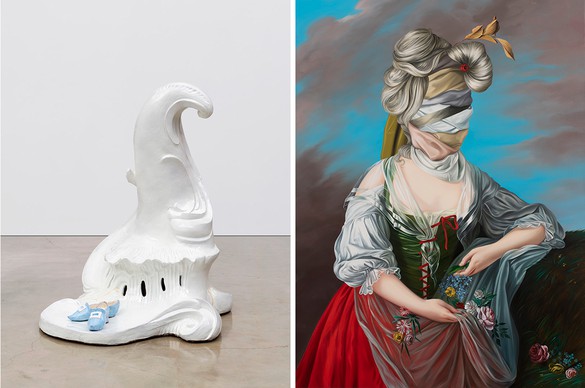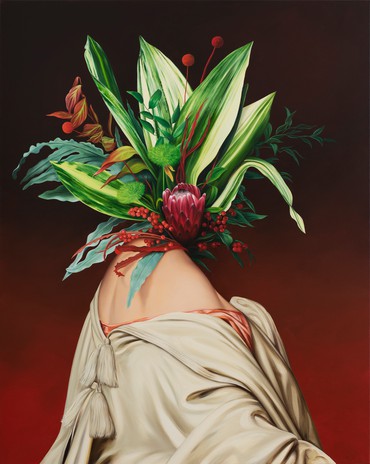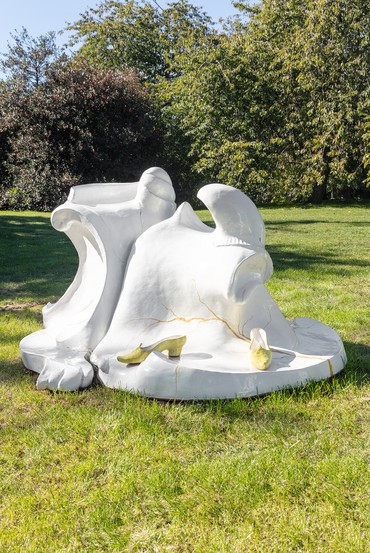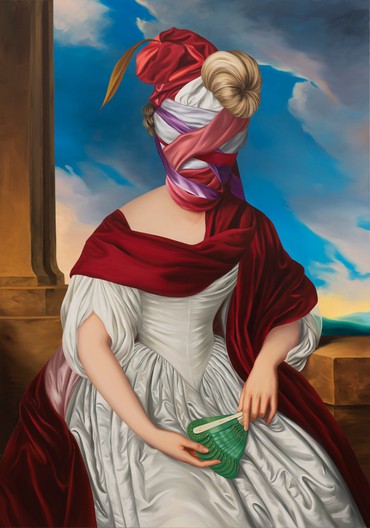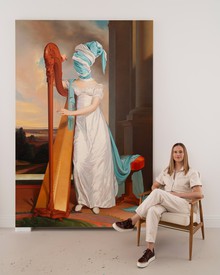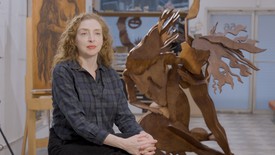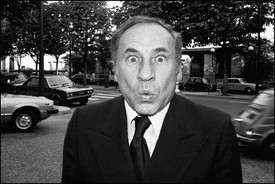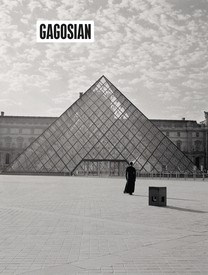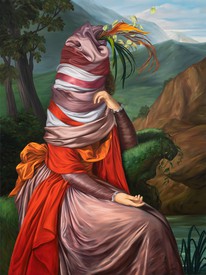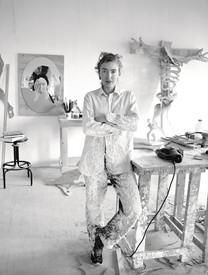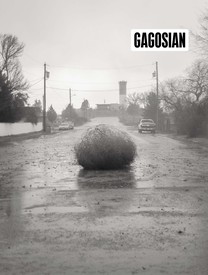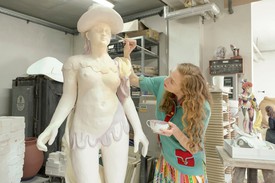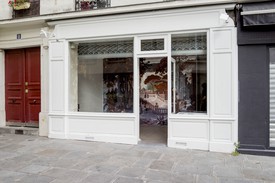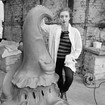
In richly detailed sculptures and multipart installations, Rachel Feinstein investigates and challenges the concept of luxury as expressed in eighteenth- and nineteenth-century Europe, in the context of contemporary parallels. By synthesizing visual and societal opposites such as romance and pornography, elegance and kitsch, and the marvelous and the banal, she explores issues of taste and desire. Photo: Markus Jans, Architectural Digest © Condé Nast
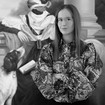
Born in Gdańsk, Poland, Ewa Juszkiewicz lives and works in Warsaw. She earned an MA in painting from the Akademia Sztuk Pięknych, Gdańsk, in 2009, and a PhD from the Akademia Sztuk Pięknych im. Jana Matejki, Krakow, in 2016. Juszkiewicz began her female portrait series in 2011 and continues to explore the unsettling possibilities it holds out, evoking the uncanny without compromising the aesthetic harmony of the images from which she works.
Rachel Feinstein When Gagosian asked me about doing the two-person booth at Frieze New York with you, the first thought was to put my porcelain pieces in, because your work would speak with them so well. But then I had the idea to make a whole body of new sculptures that are totally nasty, wild, and insane. I wanted to do something crazy, but then I realized that now may not be the right time. That’s what’s interesting about having been in this lockdown, you know, where artists don’t have any interaction. In the end, it was best to trust my first instinct and let the natural connections emerge.
Ewa Juszkiewicz I understand what you mean. During the pandemic, my studio has been the place that keeps me sane; it’s like my oasis. Over the past months, I’ve been working really intensely, and this daily routine was something that kept me calm. My workday is by definition very lonely—there’s always only me and the painting, one-on-one. But what I realized, when I looked at my paintings that I prepared for Frieze, is that I’d subconsciously transferred my longings caused by the lockdown onto these canvases. They are very diverse, and full of saturated, energetic colors. There’s a lot of lush vegetation and varied shapes. And it’s this diversity and saturation that I miss so much in my life during the pandemic. So, I appreciate that I could concentrate on work and progress in the studio in recent months.
RFI agree. It was nice to have a deadline.
EJI’m really interested in how your sculptures and my paintings will converse with one another.
RFTotally. Me too. We both love historical art; I think that’s why our work makes sense together. And I love Elisabeth Vigée Le Brun, for example. Her story is fascinating: how she was part of the royal court with Marie Antoinette and then, after the revolution, she had a very hard time, of course. I have my own feelings about why I like that period of time, but I want to hear from you first.
EJI must admit that I was always more interested in the past than in the future. My hometown, Gdańsk, in Poland, is a place with over a thousand years of history, full of monuments and old art all around. You could say that this environment shaped me, and this spirit of the past has been present in my life since childhood.
The eighteenth century is fascinating and turbulent, a time of rapid development and revolutions. The art of that period absolutely enchants me—I’m charmed by the artistry required in painting delicate fabrics, by the sophisticated colors. I love the theatrical fashion of those times, the heavily ornamental hairstyles, and the landscape designs. On the other hand, it’s impossible not to notice the omnipresent idealism in the art of that period. And a convention in presenting female images—their passive, studied poses and gestures devoid of emotions. All this provoked me to start a discussion with eighteenth-century paintings and to refer to them from a contemporary perspective.
My process is quite elaborate because the first part is the research and finding the right paintings I want to relate to in history. And when I finally choose my references, I almost immediately have a vision of how I want to deconstruct and transform a particular portrait. I imagine all these new forms and new layers, and then I start to build models: I create hairstyles, pin up fabrics, and create flower compositions. You know, I collect wigs and textiles. Sometimes I almost feel like my studio is a prop room in a theater! [Laughter.]
RFOne portrait has feathers and flowers and another one has the abundant hair. Is that just from your vision or is there a reason for your choices in particular paintings?
EJIt’s from my vision, but each reference painting gives me its own inspiration. Sometimes it comes from a fragment of the sitter’s clothes, and at other times it starts from a lock of hair or a still life in the background. There’s a lot of intuition in that, for sure. For example, in one of my paintings, I refer to a portrait by Joseph Karl Stieler. He was a German neoclassical painter who made many portraits of aristocrats. His most famous paintings are part of the so-called Gallery of Beauties. It’s a set of thirty-six portraits of the most beautiful women in Germany . . . according to the canons of the time, obviously. Anyway, the painting I’m paraphrasing is a portrait of Charlotte Baronin von Oven. It’s a well-known piece, wonderfully painted, but it also perfectly fits in this stereotype of presenting female beauty that I mentioned earlier. That’s why I decided to break its convention and reverse its message. In the original, the woman has a headband with leaves and flowers on her hair. This ornament stuck in my memory and became the starting point for my own painting composition.
RFYou mentioned the idea of nature earlier, and landscape designs. I’ve always been fascinated with that particular period of Rococo, and Baroque somewhat, because there’s this attempt to control nature. You can see that in the stylized waves in Rococo furniture and in all of the plasterwork on the walls that they would do at places like Würzburg and Amalienburg [in Germany]—it was supposed to be wild and crazy, but it’s not because it’s all about their control of the wild. Which I think goes along with how women had to wear the corsets and they had to wear the high-maintenance hairdos. My favorite story about Marie Antoinette is her Le Hameau de la Reine [The Queen’s Hamlet]: she had this little fake farm at Versailles and she would wear milkmaid outfits to go there and imagine herself as, you know, a country girl. She was drawn to the filth and the freedom of nature, but in a controlled environment. It’s a fantasy. It’s not real. Of course, nature is not controlled. You don’t know if there’s going to be a hurricane or a flash flood.
The attempt to control within Rococo suggests a sense of violence to me, actually. It’s subversive and weirdly frightening. I think it was an indication of what was going to happen, which was the French Revolution and the world just becoming completely turned on its side.
I see that connection in our work, this historical aspect. Ever since Warhol, the contemporary art world has decided to kind of turn its back on history. Now there are either traditional oil paintings done at the New York Academy of Art or there’s contemporary art, where you’re not supposed to reference history because it’s like fuddy-duddy stuff or something. So I like that you reference history—because it’s actually really difficult. I know this because my husband is John Currin, who’s always referenced historical artwork. And when he first started to do that in the early 1990s, people really didn’t get it, you know?
There’s this whole mentality behind who’s acceptable and who’s not and why that’s okay.…Who makes those rules and why? I think that you and I both have this interest particularly in that period because it’s uncool.
Rachel Feinstein
EJI agree—referring to history is a challenge. It seems to me that in our art we both constantly strike a balance between theatricality and naturalness, between the grotesque and seriousness. A very fine line separates them. But maybe that’s what attracted us in reaching for history? I believe that the most interesting things arise from the remix of conventions.
RFI think it’s also fascinating to look at which women painters made it and which ones have fallen out of favor, like how Elisabeth Vigée Le Brun is amazing, but, at the same time, people aren’t that interested in her now as compared to Artemisia Gentileschi, for example. There’s this whole mentality behind who’s acceptable and who’s not and why that’s okay. Maybe it’s political correctness. I don’t know. People get bristled by the formal portraiture of that era. Maybe they find it to be tied up in the hierarchy inherent to the idea of the monarchy. Artemisia’s work is very earthy and very sexual and it has this kind of Caravaggio experience that’s acceptable. But then Vigée Le Brun is controlled in that Rococo way and is not an acceptable female painter. Who makes those rules and why? I think that you and I both have this interest particularly in that period because it’s uncool, if that makes sense.
EJYes, there is nothing more fun than going against the tide, engaging with things that are widely considered passé. It may be that Vigée Le Brun is considered by some to be anachronistic today. But knowing her body of work and being conscious of what success she achieved in her time, in a male-dominated artistic environment, I look at her art in a different way.
RFTotally. When I was making these Nymphenburg-inspired large ceramic pieces that are now going to be shown with your paintings, I went on a tour of the Nymphenburg porcelain factory in Munich. This was around 2000, and what I saw there just stayed with me forever and ever and ever. The factory has this stream that goes through all the buildings and the stream is what is making the electricity. It was set up like this in the mid-1700s and it’s still run this way. For someone coming from Miami, where I was raised and lived until I was eighteen, it’s just a shocking sight to see something so beautiful and so part of nature in this little perfect habitat.
But I couldn’t find images of these particular little commedia dell’arte sculptures online, except for the front view. In real life, they are really small figurines, and I had to make up everything that was happening in the back of the sculpture.
And so, with only one shot for reference, I worked from the laws of Rococo design: this curve is going to have to come in and then go back out the way a wave would. Waves have a peak and valley. It’s this idea of duality, how there’s a push and pull in everything—you don’t have just a flat line. There’s going to be one thing versus the other thing. So I made up these forms, and then years later, when I finally figured out how to make them and I was in contact with Nymphenburg, I flew over there with my tiny little models. They brought out the original models that the master made in the 1750s—his name was Franz Anton Bustelli.
EJThat’s interesting!
RF I put them side by side and I took photos of my little maquettes and his maquettes. And it was incredible. It was kind of like this lightning bolt hit me. I was like, Wow, they are so similar that I can’t believe I did this without ever seeing the real thing until now. And so I wondered, have you ever had that experience? Have you made a painting from one of these sources that you never saw in person until afterward?
EJDefinitely. I usually work on the basis of the reproduction and in many cases I have no experience seeing the original painting live before. I often see them later in museums, but in some cases it’s never possible, because many of the paintings I reference are in private collections. But this sequence of things has its advantages.
RFYes, I’m the same way.
It seems to me that in our art we both constantly strike a balance between theatricality and naturalness, between the grotesque and seriousness. A very fine line separates them.
Ewa Juszkiewicz
EJI remember the words of Francis Bacon, who in a conversation with David Sylvester, in The Brutality of Fact, said that when working on his portraits, he preferred to work on the basis of photography rather than with the model present in his studio. He found that he felt less limited while working this way. Painting that involves distortion and “mutilating” an image requires absolute freedom and, consequently, solitude. I feel very much the same! I cannot imagine myself, for example, working on a painting in a museum, in front of the original piece. I don’t mean to make an imitation—I don’t have that ambition—and I would feel limited. To be honest, most of the time I work on the basis of low-quality reproductions. Sometimes it’s really better not to see every detail and to just rely on your imagination. More than an exact mapping, I care about recalling the spirit, or aura, of a given period.
I want to ask you about your technique. How long does it take you to complete a final sculpture? What does your process look like?
RFI have this cabinet of all my maquettes. I make these and I do different versions of them. One, for example, I started at this smaller size first and then I ended up doing this enormous version of it. Overall, it’s probably a lot like your process. It’s research that took me many years. I’m someone who does a lot of things at once. I have this huge sculpture going on right here. I have these paintings on mirrors that I’m doing. I have the crazy porn thing I’m doing. I kind of need to do, unfortunately, like four or five different things at the same time. And sometimes it’s crazy and I don’t know why I do that and I wish I didn’t [laughs].
EJYeah. I understand it, absolutely. I never really know which of the few ideas I’m working on will absorb me the most and in what direction they will develop. This is perhaps the most attractive aspect in our process.
RFTrue.
EJ I am constantly collecting my references and sometimes it’s many months or even years until I use them. I collect, for example, nineteenth-century natural history albums, old atlases of plants, and anonymous vintage photos of unknown origin. I can spend hours in secondhand bookstores! I keep objects and images that intrigue me and, in some way, arouse my emotions. Once in a while I come back to them and sort through them—you never know when they will give rise to something new.
